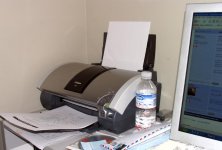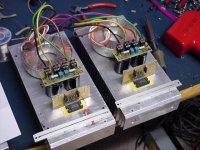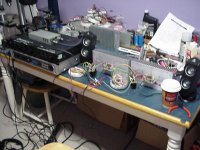Banned
Joined 2002
Thomas B said:Hi Karma, you're saying A but not B. Please elaborate. You got me really curious.
Hi Dave, right, software is wide open. But I am mostly talking about physical components. Mobo, cpu, storage, casework. Mac Mini is wide shut. You have to break it open with a knife. Make no mistake, I own Quicksilver Mac, Cinema Display, PowerBook. iBook, iPod, iShuffle, etc, I love Macs. But for computer audio I think the PC camp is leading the way right now. People who's been comparing Mac to PC's agree, PC's are holding an edge in terms of sound quality. That can rapidly change, of course. Mac software still need to be more adapted to high end audio applications though.
/Thomas B
Running windows and keeping it up todate and doing drivers is a pain in the A$$ a mac mini out of the box is already done and works. Plus it is more silent than a pc smaller than a pc and NICER LOOKING than a pc.. Me being daves side kick doing all the mac work ( well helping ) im a mac / pc tech if i were to switch to pc audio witch i wont id go for a mac mini.
hayenc said:If this thread is in Vendor's Bazaar for Peter Daniel's work, why is there a Mac discussion going on?
USB DACs... a FireWire DAC would be even better. Computer's have HUGE potential as transports becasue the ripping process doesn't have to happen in real-time, the computer can take as long as it needs to get every bit off the disk. Then it is streamed thru a RAM buffer on output.
My current USB DAC is just adequate to get music to my amp so i have been following the USB DAC thing closely. Brent has been working on one, but a PD unit would be a no-brainer. I'm not likely to afford the one i've been salivating over -- even the budget one. PDs being a kit should be no problem adding a cathode follower output stage to it so as to guild the lily.
Peter, have you seen the Stereophile article on the Brick?
dave
DAC
Peter,
Would there be a problem with using a simple DPDT switch to be able to select between reversing and non-reversing?
Robert
Peter Daniel said:
The DAC phase can be corrected (to non reversing). You simply need to reverse the connection of two traces from input buffer chip to the receiver. The next board version will have it corrected, I'm also working on optional USB interface.
Peter,
Would there be a problem with using a simple DPDT switch to be able to select between reversing and non-reversing?
Robert
Peter,
I am curios about your choice of the PCM2707. Everyone else building usb dacs has been focusing on either the 2702 ar 2902. You aren't one to make casual decisions, so I'd be interested to here your rationale.
One thing to note though, the reading I have been doing lately has been very contrary to Gordon Rankin's claims, specifically a usb interface can easily produce a jitter contaminated signal. There are very good reasons why the Burr-Brown boys spent so much time developing their line of usb-dac chips. While his usb-dac products by all accounts perform exceptionally well, Rankin is throwing around some seriously misleading marketing hype. The accurate statement would be that the usb interface is free from source related jitter, but poor dac design can still add its own jitter contribution.
Lastly Peter, what do I have to do to cajole you into adding a balanced-out option to one of your dac. Please, pretty please
Cheers, Terry
I am curios about your choice of the PCM2707. Everyone else building usb dacs has been focusing on either the 2702 ar 2902. You aren't one to make casual decisions, so I'd be interested to here your rationale.
One thing to note though, the reading I have been doing lately has been very contrary to Gordon Rankin's claims, specifically a usb interface can easily produce a jitter contaminated signal. There are very good reasons why the Burr-Brown boys spent so much time developing their line of usb-dac chips. While his usb-dac products by all accounts perform exceptionally well, Rankin is throwing around some seriously misleading marketing hype. The accurate statement would be that the usb interface is free from source related jitter, but poor dac design can still add its own jitter contribution.
Lastly Peter, what do I have to do to cajole you into adding a balanced-out option to one of your dac. Please, pretty please

Cheers, Terry
Re: DAC
I'm still not sure, I will see how it'll work out, but add on board would probably be more practical.
It should work, but I'm not sure how well. This is a sensitive area of the circuit and any switching of that sort should be rather avoided, but if you need that feature, why not give it a try.
PCM2707 was not my choice. I got evaluation board (and some other items) from Brent, so it was his choice. He did a lot research in that area and I will just see initially how well it works. I'm still waiting for a laptop I bought for that purpose.
Jitter is surely important, but it's not the only issue of a good sounding DAC.
Lastly, implementing a balanced version of a DAC is very easy. You will need two boards, and on one of them instead of receiver install a chip that reverses data signal and feed it to the other DAC chip. If I'm not mistaken, stefanobilliani is using TDA1543 in that way and he gets pretty good results. I just didn't have time yet to try it. Besides, Elso mentioned he didn't like the DAC in a balanced setup
karma said:is this going to be somthing that can be added to the dacs
we have or would it be a new one alltogether?
I'm still not sure, I will see how it'll work out, but add on board would probably be more practical.
rjkdivin said:Would there be a problem with using a simple DPDT switch to be able to select between reversing and non-reversing?
It should work, but I'm not sure how well. This is a sensitive area of the circuit and any switching of that sort should be rather avoided, but if you need that feature, why not give it a try.
metalman said:I am curios about your choice of the PCM2707. Everyone else building usb dacs has been focusing on either the 2702 ar 2902. You aren't one to make casual decisions, so I'd be interested to here your rationale.
One thing to note though, the reading I have been doing lately has been very contrary to Gordon Rankin's claims, specifically a usb interface can easily produce a jitter contaminated signal. There are very good reasons why the Burr-Brown boys spent so much time developing their line of usb-dac chips. While his usb-dac products by all accounts perform exceptionally well, Rankin is throwing around some seriously misleading marketing hype. The accurate statement would be that the usb interface is free from source related jitter, but poor dac design can still add its own jitter contribution.
Lastly Peter, what do I have to do to cajole you into adding a balanced-out option to one of your dac. Please, pretty please
PCM2707 was not my choice. I got evaluation board (and some other items) from Brent, so it was his choice. He did a lot research in that area and I will just see initially how well it works. I'm still waiting for a laptop I bought for that purpose.
Jitter is surely important, but it's not the only issue of a good sounding DAC.
Lastly, implementing a balanced version of a DAC is very easy. You will need two boards, and on one of them instead of receiver install a chip that reverses data signal and feed it to the other DAC chip. If I'm not mistaken, stefanobilliani is using TDA1543 in that way and he gets pretty good results. I just didn't have time yet to try it. Besides, Elso mentioned he didn't like the DAC in a balanced setup
PCM2706/7
The reason for using the PCM2706/7 over the PCM2702/4 is to remove SPDIF from the DAC. The PCM2706/7 has a I2S output that directly connects to the TDA1543 DAC chip. Otherwise the two chips are the same.
Kiss SPDIF good bye!
Another thing to consider is that with the current SPDIF dac you need an expensive transport to get the most out of it. Not the case with USB. Any computer that has USB 1.1 port will do. Old laptops become very useful.
I don't have any fancy transport here. I am waiting for Peter to compare the USB-->IS2 adapter to his fancy transports. I hope Peter will make a USB version if all goes well.
A USB adapter boards can be made for existing SPDIF dacs. My prototype adapter has a 8 pin socket. You pull the TDA1543 chip out the socket on the DAC, pop it into this socket then place this socket on top of the socket on the DAC. So it becomes a bit of a socket tower. But there you go, no soldering. Once that is working you can get better sound by suppling the adapter board with the 5 volts that would otherwise be powering the receiver chip.
Also see this tread for details of the PCM2706/7:
http://www.diyhifi.org/forums/viewtopic.php?p=7069#7069
The reason for using the PCM2706/7 over the PCM2702/4 is to remove SPDIF from the DAC. The PCM2706/7 has a I2S output that directly connects to the TDA1543 DAC chip. Otherwise the two chips are the same.
Kiss SPDIF good bye!
Another thing to consider is that with the current SPDIF dac you need an expensive transport to get the most out of it. Not the case with USB. Any computer that has USB 1.1 port will do. Old laptops become very useful.
I don't have any fancy transport here. I am waiting for Peter to compare the USB-->IS2 adapter to his fancy transports. I hope Peter will make a USB version if all goes well.
A USB adapter boards can be made for existing SPDIF dacs. My prototype adapter has a 8 pin socket. You pull the TDA1543 chip out the socket on the DAC, pop it into this socket then place this socket on top of the socket on the DAC. So it becomes a bit of a socket tower. But there you go, no soldering. Once that is working you can get better sound by suppling the adapter board with the 5 volts that would otherwise be powering the receiver chip.
Also see this tread for details of the PCM2706/7:
http://www.diyhifi.org/forums/viewtopic.php?p=7069#7069
Banned
Joined 2002
Peter Daniel said:As I've been doing it for more than a year already, I'm paying attention to smallest details now. Each LM4780 kit comes with a printed connection diagram, amp and PS schematics
Here is a tip for you peter.. a inkjet printer will cost you 6-8 times the price of ink than a lazer printer in color The only problem is that a lazer printers up front cost is more $$ but 399$ cdn for a color hp laser printer will go along way. A inkjet one will only drive you into the ground
J'
Peter,
I got my All-In-One populated except for the missing Riken, fuse, and power entry module. Not much extra space on that board for an amateur like me, but it sure looks nice when its done!
It was a bit tedious to get the pins for the Hammond xfmr alligned into the pcb.
What amp fuse should I use, and what is the model number for the power entry model that you used? Now I'm anxious to give it a try!
Would you like me to send the other Riken back to you?
I got my All-In-One populated except for the missing Riken, fuse, and power entry module. Not much extra space on that board for an amateur like me, but it sure looks nice when its done!
It was a bit tedious to get the pins for the Hammond xfmr alligned into the pcb.
What amp fuse should I use, and what is the model number for the power entry model that you used? Now I'm anxious to give it a try!
An externally hosted image should be here but it was not working when we last tested it.
Would you like me to send the other Riken back to you?
Lm4780
Peter,
For my LM4780 5-channel amp, would 25v+25v at 500VA for stereo, and 25v+25v at 625VA for 3 channels transformers be okay, or is the voltage creeping up a bit too much?
Robert
Parts Express has these values in stock, but nothing with 22v. John Ango on Ebay has some 22v models, but only at 400VA.
Peter,
For my LM4780 5-channel amp, would 25v+25v at 500VA for stereo, and 25v+25v at 625VA for 3 channels transformers be okay, or is the voltage creeping up a bit too much?
Robert
Parts Express has these values in stock, but nothing with 22v. John Ango on Ebay has some 22v models, but only at 400VA.
Banned
Joined 2002
Re: Shielding
It's copper for sheilding the chip.
rjkdivin said:Peter,
One more question....I noticed on your prototype All-In-One, there is some reflective tape or something on top of the CS8412??? Is this for shielding, or am I not seeing what I think I am?
Robert
It's copper for sheilding the chip.
Re: Shielding
It's always good to have some capacitors directly beside the chips. I would use something like 47-100uF there, with big caps on rectifiers board.
I had a color laser but didn't like the quality of the prints. I'm using ink jet for photography mostly (and CD covers )
)
I also have a b&w laser.
2 x 25V is fine, as long as speakers don't go too low with impedance. Actually, with higher voltage, the amps seem to sound better.
It is a copper tape, but I don't hear much difference when it's being used. I only tried it in one DAC, after a year of using it without copper shielding.
I post the info regarding fuses and AC module tomorrow. In a meantime you can solder a regular fuse and power cable directly to the board.
karma said:just wondering if i use it snuberized and parallel would i need to use non polarized caps on the amp pcb, or can i leave it blank?
It's always good to have some capacitors directly beside the chips. I would use something like 47-100uF there, with big caps on rectifiers board.
jleaman said:
Here is a tip for you peter.. a inkjet printer will cost you 6-8 times the price of ink than a lazer printer in color The only problem is that a lazer printers up front cost is more $$ but 399$ cdn for a color hp laser printer will go along way. A inkjet one will only drive you into the ground.. just food for thought..
J'
I had a color laser but didn't like the quality of the prints. I'm using ink jet for photography mostly (and CD covers
I also have a b&w laser.
rjkdivin said:Peter,
For my LM4780 5-channel amp, would 25v+25v at 500VA for stereo, and 25v+25v at 625VA for 3 channels transformers be okay, or is the voltage creeping up a bit too much?
Parts Express has these values in stock, but nothing with 22v. John Ango on Ebay has some 22v models, but only at 400VA.
2 x 25V is fine, as long as speakers don't go too low with impedance. Actually, with higher voltage, the amps seem to sound better.
rjkdivin said:Peter,
One more question....I noticed on your prototype All-In-One, there is some reflective tape or something on top of the CS8412??? Is this for shielding, or am I not seeing what I think I am?
It is a copper tape, but I don't hear much difference when it's being used. I only tried it in one DAC, after a year of using it without copper shielding.
I post the info regarding fuses and AC module tomorrow. In a meantime you can solder a regular fuse and power cable directly to the board.
- Status
- This old topic is closed. If you want to reopen this topic, contact a moderator using the "Report Post" button.
- Home
- More Vendors...
- Audio Sector
- AudioSector-chip amp kits, dacs, chassis




